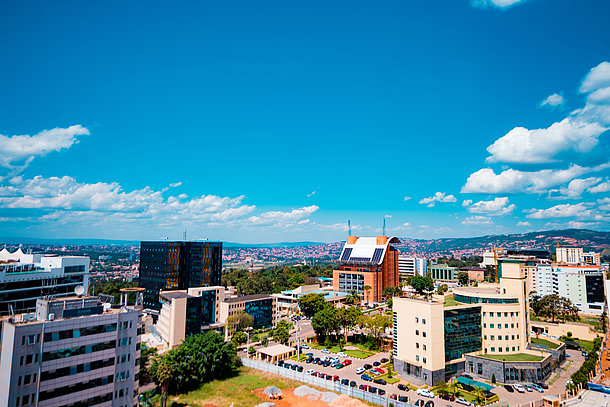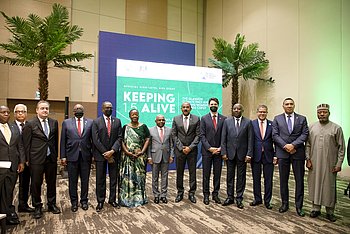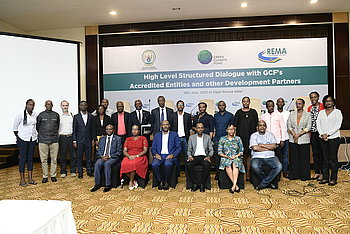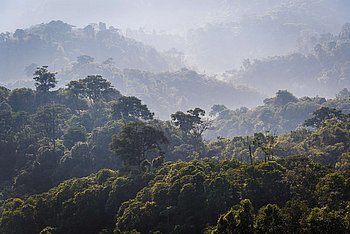
Top takeaway from Rwanda First Biennial Update Report submitted to the UNFCCC
In December 2021, Rwanda submitted the first Biennial Update Report to the United Nations Framework Convention on Climate Change (UNFCCC). This is in line of obligations for the countries under the UNFCCC.
In June 2022, this report was disseminated to all professionals and representatives from government institution and Non-Government Organizations.
Here is the report key takeaway from Rwanda First Biennial Update Report submitted to the UNFCCC.
1. The country is remarkably economically developing
The National Economic report published by Rwanda Ministry of Finance and Economic Planning (MINICOFIN) in 2019 indicated that during the fiscal year 2018/19, the economy of Rwanda recorded the highest growth in Gross Domestic Product (GDP) of 9.5 % in the last 10 years, which marks almost 3 % higher than the 10-years' average. The growth was mainly driven by the industry sector, which saw its growth double from 8 % in 2017 to 2018 to 16 % in 2018 to 2019 due to construction and manufacturing boost, which saw 25 % and 12 % growth, respectively, in 2018 to 2019.
2. There is continuous increase of greenhouse emission from 2006 to 2018
Rwanda is a country in which its emissions is low and is among the countries in which its share of emission have a negligible percentage as reported on https://ourworldindata.org/co2/country/rwanda .
The first Biennial update Report showed that even at this lowest emission, there is a continuous increase of emission, as the economic sectors are developing at high rate, this is associated by emissions increasing.
The greenhouse gas emissions were increased from 2006 to 2018 time series at 67%, from 4,033.46 Gigagramme of carbon dioxide equivalent (GgCO2e) in 2006 to 6,755 GgCO2e in 2018. This is the figure without considering the activities such as forestland, which sequestrate or remove carbon emissions.
3. The analysis of GHG emissions and removals shows that Methane had the highest share
The methane emission have the high share of 65.3 % and its main predominant source is agriculture especially from the livestock emission such as the enteric fermentation and manure management. This is linked with the population growth, economic development and urban migration, which have stimulated the animal protein demand.
Even though high share of methane emission was coming from livestock, but there are also other sources. For example, the paddy rice cultivation in flooded fields prevent oxygen from penetrating the soil, creating ideal conditions for methane emitting bacteria, and this is the source of methane emission as well.
4. The forest cover at 30.4% in Rwanda, is a great achievement in terms of greenhouse gas emission reduction
Rwanda has attained its target of reaching the forest cover of 30% in 2020. This clearly shows the country commitment in climate change mitigation. This impact has been showcased by the emission removal and sequestration that have been increase from 2006 to 2018.
In 2006, the land use change mainly the forestland areas removed 5415.96 Gigagramme of carbon dioxide equivalent (GgCO2e), while in 2018, the forestland helped to remove 7090.75 GgCO2e.
Rwanda is progressing in making the forest first in fighting the climate change. This is being done through forest planting season,in an effort to expand and restore forests and contribute to the global effort to address climate change. The season’s planting efforts included 7,400 hectares of agroforestry, 900 hectares of classic forest and 77,000 fruit trees. 500 hectares of private woodlots were rehabilitated to increase their productivity.
5. There is a need to encourage the private sector to uptake the carbon market
Only Clean Development Mechanism (CDM) and Voluntary Carbon Market (VCM) are applicable in Rwanda. Despite its low level of carbon emissions, Rwanda has potential for many types of carbon market projects due to its vision to become a developed low carbon and climate-resilient economy by 2050. However, like many other African Countries, Rwanda did not benefit much from the carbon market.
The carbon credits in Rwanda are dominated by improved cookstoves with 87% of total Certified Emission Reduction (CERs) issued, while lighting and solar PV together represent 9% and 4% respectively.
There is a need of more engagement of private sector in uptake the carbon market as public finances become increasingly constrained, there is a clear need to find resources from elsewhere to support the move to a low carbon resilient society. Clearly, the private sector has an important role to play in building a low-carbon, climate resilient future for the country through the carbon market.
Topics
More posts
COMMONWEALTH LEADERS MEET IN KIGALI TO DISCUSS WAYS OF KEEPING THE 1.5-DEGREE GOAL ALIVE
The Governments of Rwanda and the United Kingdom together with the Presidency of the United Nations Climate Change Conference (COP26) have on 23rd Jun…
Climate change as key issue that are of special in the CHOGM – 2022 discussion
The effects of climate change are being felt throughout the Commonwealth, with some Member States experiencing climate change impacts, which is a…
Public and Private sectors, Green Climate Fund accredited entities and development partners joined in the structured dialogue
On 16 June 2022 at Kigali Serena Hotel, the public, private sectors, Green Climate Fund (GCF) accredited entities and development partners have joined…
REMA AND HIGHER LEARNING INSTITUTIONS AGREED TO ENHANCE PARTNERSHIP IN ENVIRONMENT AND CLIMATE CHANGE RESEARCH
As part of the “World Environment Day Celebrations”, Rwanda is holding its annual National Environment Week. The week begun on Saturday 28 May by the…
Global Leaders Convening Tomorrow at the SEFORALL Forum in Kigali for Landmark Event on Energy and Climate
At a time when far greater action is needed to fight climate change and to reduce global inequalities, the 2022 SEforALL Forum will commence tomorrow,…
Six ways Rwanda is building climate resilient transport systems
Over the last decade, Rwanda has invested in building efficient and resilient transport systems. Guided by the country’s Green Growth and Climate…
Six ways Rwanda is being water wise in the face of climate change
Access to water underpins public health and is critical to sustainable development. Availability of water is also critical for any country’s…
Five ways Rwanda is investing in ecotourism and conservation
Rwanda is located in the Albertine Rift, a region considered especially rich in biodiversity, making it ideal for conservation and ecotourism. From…
How Rwanda is putting its forests first in the fight against climate change
In 2011, Rwanda introduced a Green Growth and Climate Resilience Strategy to guide the country to become a developed, low carbon economy by 2050.…








